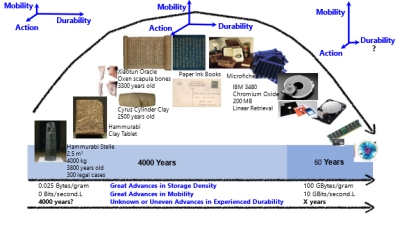Masood S. Mortazavi, Futurewei Technologies
Published: 23 Sep 2022

CTN Issue: September 2022
A note from the editor:
Since the beginning of time humans have strived to communicate with each other. Historical finds show that early “humans” communicated using pictograms that over time evolved into ideograms. At around 3500 BC the first cuneiform writing was developed by the Sumerians, while the Egyptians developed hieroglyphic writing at around the same time. Of course, there are many other forms of language and symbolic communication dating back tens of thousands of years that left no historical trace because of its nature. The other interesting aspect is how this information was stored. As an example, clay tablets and paper have proved to be a very reliable form of storage albeit with very low capacity. In this month’s article we take a detour from EM and IP and dive into a completely different topic related to textual communication. Dr. Mortazavi uses his eclectic background to take us on an informative journey regarding texting across time. “It rings odd to us today to think of writing as technology because writing has sedimented to the deep background of most currently extant human civilizations” he says. Can writing be categorized as a technology and how has it evolved? We hope you enjoy this historical ride and the perspectives he provides in this month’s article.
Miguel Dajer, CTN Editor-in-Chief
Texting Across Time

In a memorable passage in Phaedrus [1], Socrates criticizes writing as a derived mode of communication harmful to memory. He recounts how “god Theuth . . . invented numbers and arithmetic . . . and most important of all, letters”—namely, the art of writing—and proudly presented his inventions to “the king of all Egypt, god Thamus," who oblivious to Theuth's marketing his invention as an aid to memory, said: “[T]his invention of yours will produce forgetfulness in the minds of those who learn to use it, because they will not practice their memory. Their trust in writing, produced by external characters which are no part of themselves, will discourage the use of their own memory within them. You have invented an elixir not of memory, but of reminding.” [1, pp. 61-63].
Today, the irony in this Socratic critique of writing as an invented and memory-harming technology does not escape us: We have become aware of this critique simply because Socrates' most famous disciple, Plato, actually recorded this dialogue (Phaedrus) by writing it down—and now they teach it in many universities in introductory philosophy courses. In fact, what you are reading here has only been made possible for me to communicate to you across time through my use of conventional English orthography although I have spent quite a bit of time on reading and polishing it as a mini speech.
It rings odd to us today to think of writing as technology because writing has sedimented to the deep background of most currently extant human civilizations. (A good discussion of how, by contrast, Internet-attached systems still stand in the way—in the foreground—can be found in [2].) This kind of sedimentation or “disappearance-away” may be the mark of a good technology but it can still obfuscate the original intent of that technology.
When we do not recognize the derivative nature of writing as an invented mode of communication across time, we end up doing interesting but odd kinds of research, e.g., using text to intermediate automatic speech translation or attempting to establish some kind of special cognitive significance or place for text where the significance really belongs to speech. Indeed, recognizing that writing was an invented mode of communication motivated me to pursue a line of research proving that speech can directly correlate with images and that there existed no need for any text-based inter-mediation (or “pre-training”) either through ASR or through label-based image classification [3]. This was always obvious to poets and philosophers (even more modern ones [4] [5]), and we know that people who have no ability to read or write can still be great communicators—beginning with our own three or four year-old children whose speech repertoire are almost always far larger than their reading or writing ones.
Speech, and sometimes more directly body language and gestures [6], are the primordial and living mode for human-human communication while, on the other hand, writing systems are deliberate human inventions for derivative modes of human-human communication with which we attempt to bridge gaps across time: What we write today will be read at some future time, if at all. In general, all technologies have something to do with bridging the primordial gaps in our limited existence—gaps in time, gaps in space and gaps in user-interface or what we may call trans-actional action. Technologies facilitate durability, mobility and action (Figure 1), dimensions that also need to be balanced to ensure the social life of information [7].

In our preoccupation with technology, it is natural to ask what makes a technology “good” or “sticky” to human physiology, culture, existence and civilization: In 1901-1902 in Susa, Iran, French archaeologists discovered a 4000-year-old, 4000-kg stele (taken and now displayed in the Louvre Museum) which bore the Code of Hammurabi: A Babylonian legal text containing roughly 300 laws governing trade contracts, military draft and family life. The stele has apparently been a very good (we may say, excellent) storage technology. It has survived some 4000 years and has suffered only two major moves in its long history which prove its major weakness: its lack of mobility. The Babylonians knew about the mobility (and user-interface) weakness of the stele, and they used various technologies (such as clay tablets) to run copies of the laws across parts of West Asia where their empire stretched.
The textual information density on the Hammurabi stele (without any compression) runs at about 0:025 bytes-per-gram. This is based on a rough estimate of the number of characters that would need to be used to write its 300 or so legal clauses in an English translation. The mobility runs at about 0 bytes-per-second. As noted, it has only been moved twice in its entire life.
By contrast, some 10 years ago, data storage mini-cards were already carrying 100 giga-bytes-per-gram with access rates approaching 10 giga-bytes-per-second. I used some of these storage cards to record videos at family events and I am now not sure where they are in my home office. So, perhaps, I cannot say I know about their experienced durability, and we probably all need to wait 4000 years for Amazon S3 to have a provable claim of experienced durability over and above the Hammurabi Stele. Despite its lack of mobility, there are other things that the Hammurabi stele (or any of its clay-tablet copies) has going for it: Its user interface demands no secondary devices and no energy or specially-designed electronics to run it. In fact, it itself is its own silent, highly power-efficient user interface.
In general, we invent technologies that seek to strike a balance, either by themselves or in combination with other invented technologies, in a three-dimensional objective space of durability, mobility and user-interface, and all of this brings us back to paper as an ideal case study (Figure 1). Compared to writing, it is far more obvious that paper (originally, invented in China) is indeed a kind of technology that on its own strikes a superb balance in durability, mobility and user-interface features. We store (record) documents on paper, or at least we did this for a very long time, very effectively, because paper has had several very unique features that are hard to replicate and which make it truly special and a great case study about what “good” technology is and how it works. In the last century, there has been tremendous gains in mobility but when it comes to recording and reading text, we still are struggling to create a system that competes with paper and has all of its unique advantages—features which must have been discovered as necessary through centuries of experience.
In the meantime, my WSJ print edition, which is now waiting at the table along with my morning coffee, is still infinitely easier to review quickly than the online version. I can fold it in many ways, and its design guides my eyes from story to story on a vast surface (when unfolded) and I can scan everything very quickly without any need to plug anything into anything.
Yes, it is odd to think of old stuff as technology but unless we do that and understand what made them so uniquely useful, we cannot feed our imagination to create truly new and relatively stable environments within which we can all prosper and learn from our accumulated human experience generation after generation.
References
- Plato and H. N. Fowler, Plato: Euthyphro; Apology ; Crito ; Phaedo ; Phaedrus, Harvard University Press, 1914.
- H. L. Dreyfus, On the Internet, Routledge, 2001.
- M. S. Mortazavi, "Speech-image semantic alignment does not depend on any prior classifocation tasks," in Proceedings of InterSpeech, 2020.
- G. Ryle, The Concept of Mind. U of Chicago Press, 1949.
- C. Lewis, The Poetic Image (Clark Lectures), Cambridge, 1946.
- D. McNeill, Gesture and Thought, Chicago University Press, 2005.
- J. S. Brown and P. Duguid, The Social Life of Information, Harvard Business Review Press, 2000.
Statements and opinions given in a work published by the IEEE or the IEEE Communications Society are the expressions of the author(s). Responsibility for the content of published articles rests upon the authors(s), not IEEE nor the IEEE Communications Society.


